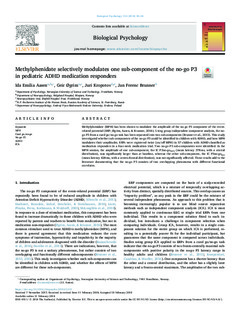| dc.contributor.author | Brunner, Ida Emilia | |
| dc.contributor.author | Øgrim, Kjell Geir | |
| dc.contributor.author | Kropotov, Juri D | |
| dc.contributor.author | Brunner, Jan Ferenc | |
| dc.date.accessioned | 2019-02-13T13:52:53Z | |
| dc.date.available | 2019-02-13T13:52:53Z | |
| dc.date.created | 2018-03-01T18:09:20Z | |
| dc.date.issued | 2018 | |
| dc.identifier.citation | Biological Psychology. 2018, 134 30-38. | nb_NO |
| dc.identifier.issn | 0301-0511 | |
| dc.identifier.uri | http://hdl.handle.net/11250/2585270 | |
| dc.description.abstract | Methylphenidate (MPH) has been shown to modulate the amplitude of the no-go P3 component of the event-related potential (ERP; Øgrim, Aasen, & Brunner, 2016). Using group independent component analysis, the no-go P3 from a cued go/no-go task has been separated into two sub-components (Brunner et al., 2013). This study investigated whether sub-components of the no-go P3 could be identified in children with ADHD, and how MPH modulates their amplitudes. ERPs were registered twice (on/off MPH) in 57 children with ADHD classified as medication responders in a four-week medication trial. Two no-go P3 sub-components were identified. In the MPH session, the amplitude of one sub-component, the IC P3no-goearly (mean latency 378 ms, with a central distribution), was significantly larger than at baseline, whereas the other sub-component, the IC P3no-golate (mean latency 428 ms, with a centro-frontal distribution), was not significantly affected. These results add to the literature documenting that the no-go P3 consists of two overlapping phenomena with different functional correlates. | nb_NO |
| dc.language.iso | eng | nb_NO |
| dc.publisher | Elsevier | nb_NO |
| dc.rights | Attribution-NonCommercial-NoDerivatives 4.0 Internasjonal | * |
| dc.rights.uri | http://creativecommons.org/licenses/by-nc-nd/4.0/deed.no | * |
| dc.title | Methylphenidate selectively modulates one sub-component of the no-go P3 in pediatric ADHD medication responders | nb_NO |
| dc.title.alternative | Methylphenidate selectively modulates one sub-component of the no-go P3 in pediatric ADHD medication responders | nb_NO |
| dc.type | Journal article | nb_NO |
| dc.type | Peer reviewed | nb_NO |
| dc.description.version | publishedVersion | nb_NO |
| dc.source.pagenumber | 30-38 | nb_NO |
| dc.source.volume | 134 | nb_NO |
| dc.source.journal | Biological Psychology | nb_NO |
| dc.identifier.doi | 10.1016/j.biopsycho.2018.02.011 | |
| dc.identifier.cristin | 1569895 | |
| dc.description.localcode | © 2018 The Author(s). Published by Elsevier B.V. This is an open access article under the CC BY-NC-ND license (http://creativecommons.org/licenses/BY-NC-ND/4.0/). | nb_NO |
| cristin.unitcode | 194,67,40,0 | |
| cristin.unitname | Institutt for psykologi | |
| cristin.ispublished | true | |
| cristin.fulltext | original | |
| cristin.qualitycode | 2 | |

